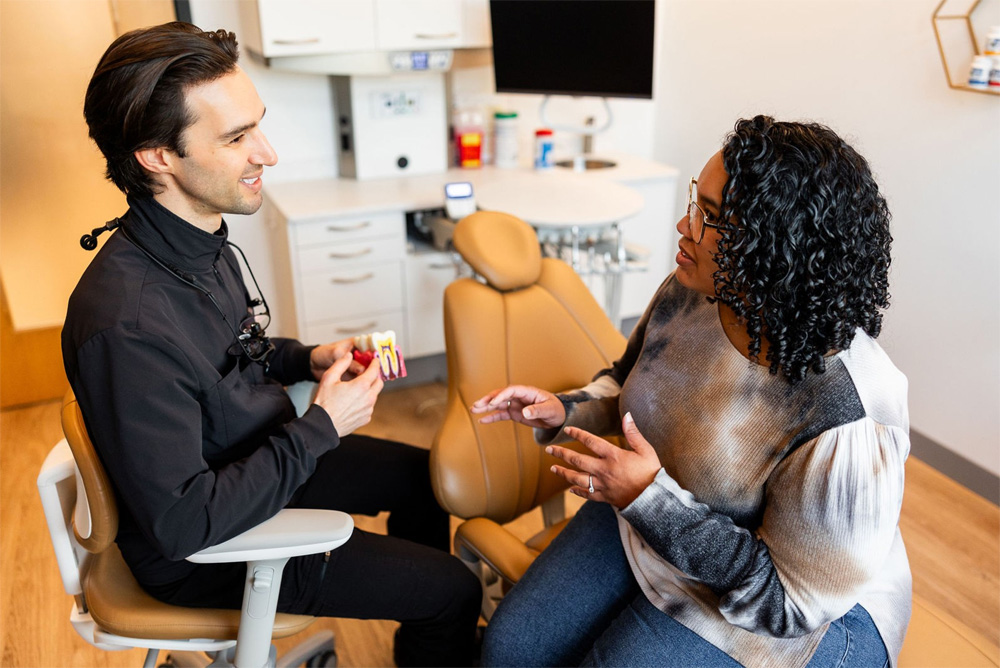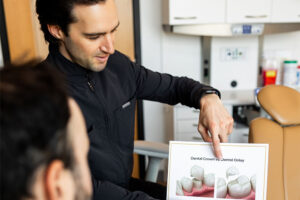Gum Recession Explained: Causes, Warning Signs, and Solutions

Have you ever looked in the mirror and thought, “Were my teeth always this long?” Or perhaps you have noticed gaps in your teeth at your gum line or have sensitivity to hot or cold.
If so, you may be dealing with gum recession. It’s a sneaky problem that can creep up over time, making your teeth more sensitive and vulnerable to damage as your roots become exposed. The good news? You don’t have to sit back and let it happen. While serious gum recession is only reversible through surgical interventions, you can still take proactive steps to stop it before it becomes a big problem.
Gum recession can be caused by several factors, from orthodontic trauma to gum disease and oral ties. At Restoration Dentistry, we take a functional approach to addressing and preventing gum recession through education and holistic treatment methods. Let’s dive into what gum recession is, what causes it, and, most importantly, how you can keep your gums happy and healthy for years to come.
What Is Gum Recession?
Gum recession occurs when the gum tissue surrounding your teeth starts pulling away, exposing more of the tooth’s surface and root. This can lead to increased sensitivity, a higher risk of cavities and tooth decay, and, in severe cases, tooth loss. It’s a slow progression, but one you shouldn’t ignore.
There are several reasons why your gums might be receding, including:
- Orthodontic trauma
- Toothbrush trauma
- Occlusal disease
- Bruxism (teeth grinding)
- Gum disease
- Oral ties
Because gum recession is often slow-acting, the early warning signs can be subtle. You may notice your teeth look longer or are more sensitive to temperature. Your gums may also become swollen or tender and bleed when you brush or floss. If you experience any of these symptoms, it is critical that you contact your dentist immediately to schedule an appointment and get the necessary treatment to stop your gum recession before it becomes a serious problem.
How to Prevent Gum Recession
The key to stopping gum recession is addressing the primary reason before it can worsen and cause significant damage. Let’s look at each main cause of gum recession and how you can take proactive steps to prevent it.
Orthodontic Trauma
If you have had braces or other orthodontic work, your jawbone may not have fully reformed after your teeth shifted. Because your gum tissue is affected by your bone density, you will also lose gum tissue. A CBCT or 3D X-ray should be taken prior to any orthodontic treatment to assess your bone density and gum health so it can be closely monitored during orthodontic treatment. Finding an orthodontist who takes a conservative approach to your orthodontic treatment to prevent your teeth from shifting too quickly is also an excellent option for avoiding gum recession.
Toothbrush Trauma
Medium and hard-bristled toothbrushes are too abrasive to your teeth and gums, causing gum recession. You should opt for a soft-bristled toothbrush and use gentle motions to protect your gums. An electric toothbrush with a round head is an ideal choice, as they do all the brushing for you.
Occlusal Disease
Occlusal disease occurs when you have an uneven bite, causing excessive pressure on specific teeth. This can lead to localized gum recession over time. The end goal of treating occlusal disease is to create ideal bite alignment while the jaw is stable. Dr. Clayton takes a functional approach to occlusal disease by using a Kois Deprogrammer device to identify the ideal bite for you, correct it, and help you prevent jaw pain as well as gum recession.
Grinding (Bruxism)
Tooth grinding or Bruxism can be a major contributor to gum recession as it puts excessive force on your teeth and gums. Common signs of bruxism include jaw pain, headaches, and worn-down teeth. Teeth grinding can be attributed to airway issues, occlusal disease, or true bruxism, which is a neurological disorder (true for approximately 8% of cases). Understanding the root cause of your grinding is essential in developing a treatment plan that addresses your specific needs to prevent grinding and subsequent gum recession. While true bruxism (8%) has no real solution, some helpful tips for grinding are to wear a nightguard while you sleep to help reduce the damage caused by the grinding, utilize meditation, herbal teas, and other relaxation techniques to help calm your brain before sleep.
Gum Disease
Gum disease is one of the leading causes of gum recession and can be treated through quality oral care. Maintaining a solid oral hygiene routine that includes brushing twice daily and flossing is essential to prevent gum disease. Finding a functional dentist is also ideal for preventing and treating gum disease in order to identify the root cause. Dr. Clayton uses saliva testing to identify the root cause of your gum disease and Guided Biofilm Therapy, which uses air, water, and erythritol powder to thoroughly and effectively clean plaque and tartar and reset the oral biofilm in the mouth. This innovative system also reaches below the gumline into deeper pockets to remove harmful bacteria that cause gum recession.
Oral Ties
Tongue, lip, and buccal ties can contribute to localized gum recession by pulling excessively on the gums. Dr. Clayton uses a gentle CO2 laser to precisely release the restrictive tissue causing oral ties. He also takes an interdisciplinary approach to oral ties by including myofunctional therapy, cranioSacral therapy, physical therapy,, chiropractic, and orthodontics, as needed to ensure the best possible outcome for your oral tie release.
Get Personalized Gum Recession Treatment at Restoration Dentistry
Dr. Clayton and our team at Restoration Dentistry take a comprehensive, functional approach to treating and preventing gum recession. We don’t just address the symptoms – we work to identify and treat the primary causes using innovative techniques like saliva testing, guided biofilm therapy, and thorough, comprehensive patient education.
Ready to protect your smile and stop gum recession in its tracks? Schedule a comprehensive evaluation with our team to take the first step toward optimal oral health. Our personalized treatment plans address your needs, whether you’re dealing with orthodontic trauma, occlusal disease, or other factors contributing to your gum recession. Contact Restoration Dentistry today at (208) 229-1500 or through our contact form.


